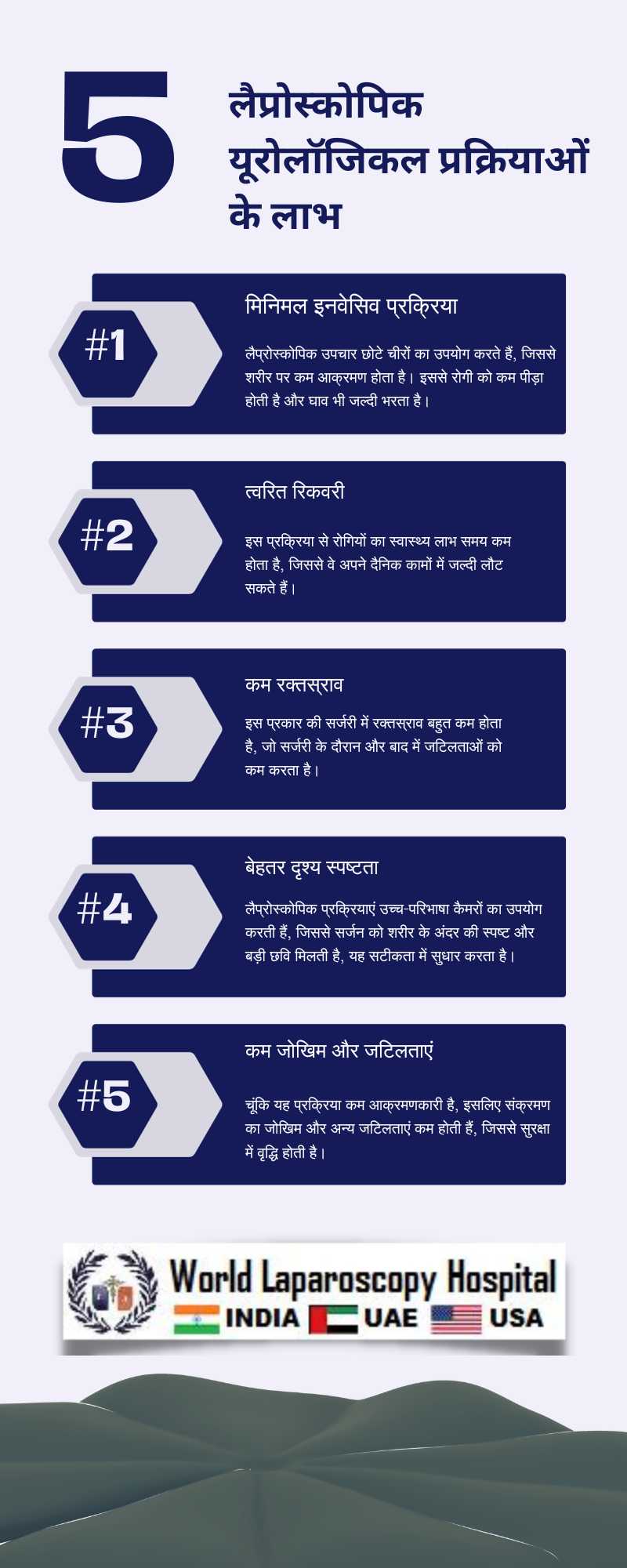लैप्रोस्कोपिक यूरोलॉजिकल प्रक्रियाओं के लाभ
Essay on Advantages of Laparoscopic Urological Procedures
Laparoscopic urological procedures represent a significant advancement in the field of urology, offering numerous benefits over traditional open surgery. This essay outlines the advantages of these minimally invasive techniques, emphasizing their impact on patient outcomes, recovery times, and overall healthcare efficacy.

1. Reduced Trauma and Scarring: One of the most significant benefits of laparoscopic urological procedures is the reduced trauma to the patient. Traditional open surgeries require large incisions, which can result in considerable scarring and postoperative pain. In contrast, laparoscopic surgery involves small incisions, often less than a centimeter, through which specialized instruments and a camera are inserted. This approach drastically reduces scarring and the physical impact on the patient.
2. Shorter Hospital Stays and Faster Recovery: Due to the minimally invasive nature of laparoscopic procedures, patients generally experience shorter hospital stays. The reduced trauma from smaller incisions typically results in less postoperative pain and complications, which accelerates the recovery process. Patients are often able to resume their normal activities much sooner than they would after traditional open surgery.
3. Decreased Risk of Infection: The smaller incisions used in laparoscopic surgery significantly reduce the exposure of internal organs to external contaminants, thereby lowering the risk of postoperative infections. This is crucial in urological procedures, where the risk of infection can be high due to the nature of the organs involved.
4. Improved Surgical Outcomes: Laparoscopic techniques provide surgeons with enhanced visualization of the surgical area. The use of a camera offers a magnified view and better illumination, enabling more precise and delicate maneuvers. This precision often leads to improved surgical outcomes, with fewer complications and better preservation of healthy tissues.
5. Reduced Blood Loss and Need for Transfusions: The precision of laparoscopic surgery, combined with advanced techniques for controlling bleeding, typically results in less blood loss during surgery. This reduces the need for blood transfusions, lowering the associated risks and improving overall patient safety.
6. Enhanced Patient Comfort and Satisfaction: Patients undergoing laparoscopic urological procedures often report higher levels of comfort and satisfaction. The reduced pain and quicker return to normal life are significant factors in this enhanced patient experience. Moreover, the cosmetic benefits of smaller scars contribute to a more positive body image post-surgery.
7. Cost-Effectiveness: Although the initial cost of laparoscopic equipment and training may be high, these procedures can be more cost-effective in the long run. Shorter hospital stays, fewer complications, and faster return to work contribute to reduced overall healthcare costs.
Conclusion:
Laparoscopic urological procedures offer numerous advantages over traditional open surgeries. These benefits include reduced trauma and scarring, shorter hospital stays, decreased risk of infection, improved surgical outcomes, reduced blood loss, enhanced patient comfort, and overall cost-effectiveness. As technology continues to advance, these techniques are likely to become even more effective, further revolutionizing the field of urology and patient care.
Laparoscopic urological procedures represent a significant advancement in the field of urology, offering numerous benefits over traditional open surgery. This essay outlines the advantages of these minimally invasive techniques, emphasizing their impact on patient outcomes, recovery times, and overall healthcare efficacy.

1. Reduced Trauma and Scarring: One of the most significant benefits of laparoscopic urological procedures is the reduced trauma to the patient. Traditional open surgeries require large incisions, which can result in considerable scarring and postoperative pain. In contrast, laparoscopic surgery involves small incisions, often less than a centimeter, through which specialized instruments and a camera are inserted. This approach drastically reduces scarring and the physical impact on the patient.
2. Shorter Hospital Stays and Faster Recovery: Due to the minimally invasive nature of laparoscopic procedures, patients generally experience shorter hospital stays. The reduced trauma from smaller incisions typically results in less postoperative pain and complications, which accelerates the recovery process. Patients are often able to resume their normal activities much sooner than they would after traditional open surgery.
3. Decreased Risk of Infection: The smaller incisions used in laparoscopic surgery significantly reduce the exposure of internal organs to external contaminants, thereby lowering the risk of postoperative infections. This is crucial in urological procedures, where the risk of infection can be high due to the nature of the organs involved.
4. Improved Surgical Outcomes: Laparoscopic techniques provide surgeons with enhanced visualization of the surgical area. The use of a camera offers a magnified view and better illumination, enabling more precise and delicate maneuvers. This precision often leads to improved surgical outcomes, with fewer complications and better preservation of healthy tissues.
5. Reduced Blood Loss and Need for Transfusions: The precision of laparoscopic surgery, combined with advanced techniques for controlling bleeding, typically results in less blood loss during surgery. This reduces the need for blood transfusions, lowering the associated risks and improving overall patient safety.
6. Enhanced Patient Comfort and Satisfaction: Patients undergoing laparoscopic urological procedures often report higher levels of comfort and satisfaction. The reduced pain and quicker return to normal life are significant factors in this enhanced patient experience. Moreover, the cosmetic benefits of smaller scars contribute to a more positive body image post-surgery.
7. Cost-Effectiveness: Although the initial cost of laparoscopic equipment and training may be high, these procedures can be more cost-effective in the long run. Shorter hospital stays, fewer complications, and faster return to work contribute to reduced overall healthcare costs.
Conclusion:
Laparoscopic urological procedures offer numerous advantages over traditional open surgeries. These benefits include reduced trauma and scarring, shorter hospital stays, decreased risk of infection, improved surgical outcomes, reduced blood loss, enhanced patient comfort, and overall cost-effectiveness. As technology continues to advance, these techniques are likely to become even more effective, further revolutionizing the field of urology and patient care.
कोई टिप्पणी पोस्ट नहीं की गई ...
| पुराना पोस्ट | मुख्य पृष्ठ | नई पोस्ट |




